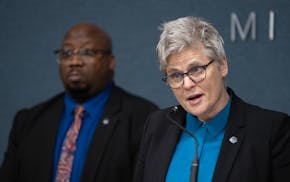Opinion editor's note: Star Tribune Opinion publishes a mix of national and local commentaries online and in print each day. (To contribute, click here.) This article is a response to Star Tribune Opinion's June 4 call for submissions on the question: "Where does Minnesota go from here?" Read the full collection of responses here.
•••
It's being called the New Minnesota Miracle. Our children are smiling, even the babies with their lopsided grins. The Legislature and governor have taken steps to make our state a great place to be a child.
If anything will change the landscape and have an impact on future generations of Minnesotans, it is the recent legislation providing support and funding for our youngest citizens: our babies and toddlers.
The paid family and medical leave program, child tax credit, increased assistance with child care costs and better pay for our child care workforce all benefit those whose lives are just beginning and whose prospects for success are being determined. Because many studies show that a child's brain development benefits or suffers from life's earliest experiences, it's important to get it right.
In the short term, complainers will ask (and are asking), "Why not bigger rebates?" and, "Why did the Democrats spend so much?" They choose to forget that these programs have been blocked or greatly underfunded for the past 20 years and catch-up expenditures were badly needed. Our children have been waiting too long and children can't wait.
In the next phase, when these programs have been in place for several years (beyond the terms of our farsighted elected officials), we will begin to hear the stories, whether online or in this newspaper, of the families whose lives have been eased by the child tax credit bringing one-third of children out of poverty, of the child care worker who now can afford to stay in the job he or she loves, and of the parent who is able to stay with their sick newborn in the neonatal intensive care unit without the loss of a paycheck or a job.
The new Minnesota Department of Children and Families will provide coordination of services and collect data on how our children are doing and which programs are showing the best results.
Finally, the real rewards for the vision of this courageous Legislature will accumulate in future years as many more babies and toddlers get what they need for optimal brain development and arrive at preschool and at kindergarten well-prepared and ready to learn. Educational and achievement gaps will shrink and success in school will lead to fewer dropouts and incarcerations among many other successes lifelong. Employers will keep valued employees through the illnesses and family responsibilities that affect us all. Young citizens, their families, and the caregivers and teachers who support them will have a new status recognizing their significance to the future of our state.
Improving family economic security will show long-lasting results, especially for the disproportionate number of families of color who struggle with intergenerational poverty. Stress related to food insecurity, evictions, school failure and job loss all affect the health of our population. Relieving that stress will help decrease the incidence of many chronic conditions that have precursors early in life.
Better education, especially in early childhood, sets the stage for lifelong health. By giving parents time to bond with their newborn or stay home with a sick child, and helping families with the expense of child care, we will be investing in a long-term goal: a healthier and better-educated population across all ethnic and racial groups.
In future years, all over Minnesota, people will say, "Remember 2023? That was when we turned it around. We did it for the kids. And it was good."
Mary Meland, Dale Dobrin, Ada Alden and Roger Sheldon are members of the child advocacy group Doctors for Early Childhood.

BWCA's future likely hinges on election
Saving the dinosaurs: Why there's a future for community newspapers
Readers Write: Gun storage laws, Uber and Lyft, 24/7 businesses, the pipe organ


